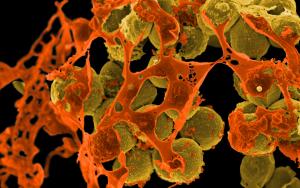
STAT3 dominant-negative disease (STAT3DN)—also known as autosomal dominant hyper-IgE syndrome (AD-HIES) or Job’s Syndrome—results from mutations in the gene that encodes a signaling protein called STAT3. People with this disease tend to have very high levels of an antibody called immunoglobulin E (IgE), recurrent infections of the skin and lungs, recurrent bone fractures, unusually flexible joints, and inflamed skin.
Why Is the Study of STAT3 Dominant-Negative Disease a Priority for NIAID?
STAT3 dominant-negative disease has widespread deleterious effects on patients’ health, so NIAID scientists aim to develop and enhance treatments to improve patients’ quality of life. In addition, NIAID scientists hope that studying this disease will help them better understand the physiological processes associated with the genetic tendency to develop certain types of infections and allergic diseases.
How Is NIAID Addressing This Critical Topic?
NIAID investigators identified the role of STAT3 in this disease in 2007. Since then, NIAID-supported researchers have made multiple discoveries about how the loss-of-function mutation in the STAT3 gene leads to patients’ symptoms. NIAID-supported clinical research seeks to determine the effect of STAT3 dominant-negative disease on the immune system, including which immune cells and responses are affected and how these abnormalities translate into patients’ symptoms.
What's New
Latest News Releases
NIAID Now Blog
- Addressing Rare Diseases—Gene Therapy and Beyond
February 20, 2020 - Newborn Screening Aids Discovery of Novel Gene Variants
August 22, 2019
Causes
STAT3 dominant-negative disease results from mutations in the gene that encodes a signaling protein called STAT3. This protein is involved in many different activities of the body, explaining why the disease affects not only the immune system but also facial appearance, bones, lungs, skin, and arteries.
Symptoms & Diagnosis
People with STAT3 dominant-negative disease (STAT3DN) may have recurrent infections of the skin and lungs. These infections are often caused by the bacterium Staphylococcus aureus but may also be caused by other bacteria and fungi. IgE levels in most patients are extremely high. Patients also tend to have rashes from birth, recurrent bone fractures, unusually flexible joints, and inflamed skin. Baby teeth in people with STAT3DN often do not fall out on their own. A doctor will suspect this disease in a person with eczema, recurrent boils, and pneumonias.
Treatment
The most effective treatments for STAT3 dominant-negative disease are continuous antibiotics and antifungals as needed, as well as careful monitoring for infections, which can be severe even when symptoms do not appear so. Some patients receive antibody replacement therapy. Antiseptic approaches, such as dilute bleach baths, often help prevent skin infections and improve eczema

